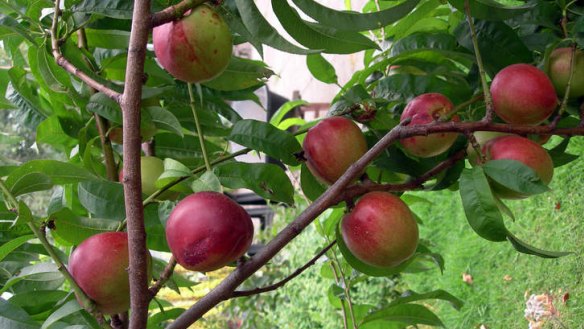Chill factor crucial

There is a delicate aspect to the smooth-skinned nectarine, which has firm and juicy flesh when picked ripe off your backyard tree. Nectarines are self fertile so you can grow just one, but two or three will extend your harvest season.
If you have a brick wall to espalier a nectarine tree then you can provide extra overnight warmth in spring. Most nectarines need 600 to 800 chill hours over winter to properly set next season's buds and fruit but some have been bred for good crops after a short and mild winter. Canberra can deliver a high number of chill hours but the other factor is the timing of flowering. In Canberra, you can expect your nectarines to be covered with light pink blossoms before the end of August so you will always have the risk of a heavy frost taking away the life of many blossoms.
Nectarines, and their cousin the peach, will produce flowers and fruit on last season's new wood. They will generally fruit on laterals, which should be kept to about 40 centimetres in length. When you do your winter pruning, take off laterals that have already fruited and leave new laterals with a spacing of about 20 centimetres. Also prune the high branches quite hard to keep the new growth at a manageable height.
Nectarines need good, deep regular watering as the fruit is maturing to avoid splitting. They like a deep mulch to keep the moisture in and weeds at bay.
In history, there are few references to nectarines compared with peaches and 150 years ago in the United States there were only 19 varieties listed in one supplier catalogue. But they have proliferated in recent decades and now there are hundreds of variations of skin colour, juiciness and time of ripening. In some ways they are less hardy and a little more difficult to produce a good crop from than peaches, although they are closely related.
Most nectarines will have a very bright red skin with some yellow background. Varieties such as flavortop, goldmine, sunglo and late le grand are freestone and are high yielding. Nectared and fairlane are clingstone.
Nectarines will often set a huge crop if the season goes well. In such years it is a good idea to thin off vigorously, if possible in October or early November, to allow all of the growth energy to flow into the remaining fruit. This will markedly increase the size of each piece of fruit. A fully grown tree can produce a wonderful harvest of 600 to 800 large nectarines.
You can do much to minimise the likelihood of brown rot. Carefully remove any mummified fruit that may be hanging on the tree at the end of the season and pick up any that have fallen on the ground. A pre-budburst spray with the copper-based Kocide will provide extra control for brown rot and leaf curl fungi in early spring.
Owen Pidgeon owns the Loriendale Organic Orchard near Hall.